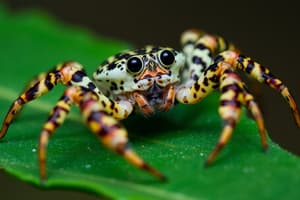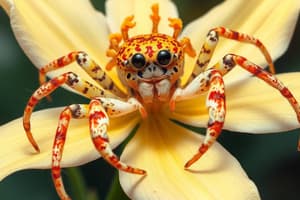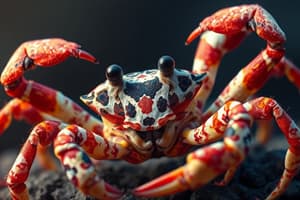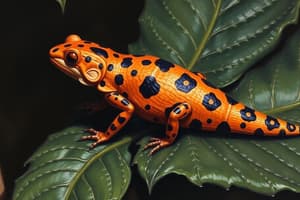Podcast
Questions and Answers
What best describes mimicry in the context of animal behavior?
What best describes mimicry in the context of animal behavior?
- When one species resembles another that has recognizable traits. (correct)
- A defense mechanism for blending into surroundings.
- A strategy involving the consumption of different food types.
- The ability to locate food sources effectively.
What is the primary function of camouflage in organisms?
What is the primary function of camouflage in organisms?
- To protect themselves by blending into their environment. (correct)
- To attract mates through vibrant colors.
- To establish dominance over other species.
- To enhance their ability to hunt more effectively.
How do competing species typically adjust to coexist in the same environment?
How do competing species typically adjust to coexist in the same environment?
- By utilizing the same resources more efficiently.
- By using different areas of the environment and consuming different foods. (correct)
- By altering their fundamental niche to match their competitor.
- By engaging in direct competition for resources.
What does a stronger competitor have in relation to its niche?
What does a stronger competitor have in relation to its niche?
What is the meaning of diversity of resources in ecological terms?
What is the meaning of diversity of resources in ecological terms?
How does mimicry benefit the mimic species and what is a common example in nature?
How does mimicry benefit the mimic species and what is a common example in nature?
In what ways does camouflage enhance an organism's chances of survival?
In what ways does camouflage enhance an organism's chances of survival?
What role does resource diversity play in the survival of a species within its ecosystem?
What role does resource diversity play in the survival of a species within its ecosystem?
Explain how the concept of niche differentiation helps species coexist in the same habitat.
Explain how the concept of niche differentiation helps species coexist in the same habitat.
What does it indicate about a stronger competitor if they have the same realized and fundamental niche?
What does it indicate about a stronger competitor if they have the same realized and fundamental niche?
Flashcards are hidden until you start studying
Study Notes
Mimicry
- One species of animal (the mimic) resembles another species that has easily recognizable characteristics.
Camouflage
- Also called cryptic coloration
- A defense mechanism that organisms use to disguise their appearance to blend in with their surroundings.
Resource Diversity
- The diversity of resources used or environments tolerated by an individual, population, species, or clade.
Resource Partitioning
- The process by which competing species use the environment differently in a way that helps them to coexist.
- Competing species tend to compete less strongly
- Competing species consume different foods
- Using different areas of the environment reduces competition.
- The stronger competitor will have the SAME realized and fundamental niche.
Mimicry
- One species (the mimic) resembles another species.
- The mimicked species has easily recognizable characteristics.
Camouflage
- Also known as cryptic coloration.
- A defense mechanism.
- Organisms disguise their appearance.
- Blend in with their surroundings.
Niche
- Diversity of resources an individual, population, species, or clade uses.
- Environments tolerated by an individual, population, species, or clade.
Resource Partitioning
- Competing species use the environment in different ways.
- Helps species coexist.
- Species compete less strongly.
- Consume different foods.
- Use different areas of the environment.
Stronger Competitor
- Has the same realized and fundamental niche.
Studying That Suits You
Use AI to generate personalized quizzes and flashcards to suit your learning preferences.





